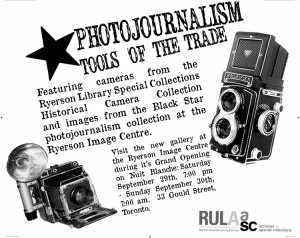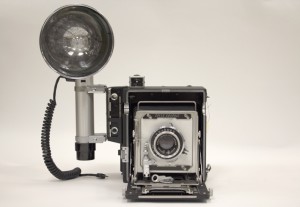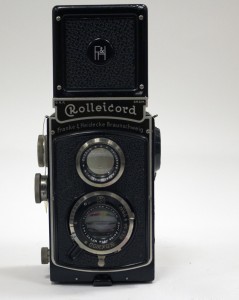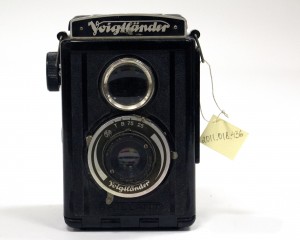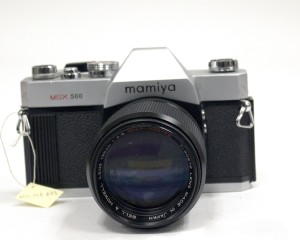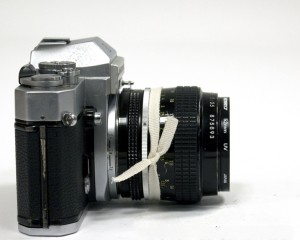New Exhibition: Special Collections display cases, 4th floor of the Ryerson Library the Ryerson Library building.
In recognition of the grand opening of the Ryerson Image Centre, Special Collections has put together a small exhibition featuring images of journalists from the Black Star collection with their cameras of choice and a selection of similar cameras from the Historical Camera Collection.
Drop by the 4th floor of the Ryerson Library to see the exhibition.
GRAFLEX CAMERAS
Developed and produced in the United states, the Graflex camera was favoured by photojournalists since it’s introduction in 1910. This version from the 1940’s uses 4” x 5” sheet film (mounted in a film holder in the back of the camera) and the flash attachment used 1-time use flash bulbs. The strong flash gave photographs the telltale high contrast look of news and paparazzi photographs from the 40’s and 50’s. Dorothea Lange used a similar Graflex model (series D) to shoot iconic images for the Farm Securities Association from 1935-1939.
TWIN LENS REFLEX CAMERAS
Twin-lens reflex cameras use two lenses, one to view and focus through (above) and one to take the photograph (below). A 45° mirror sends the image from the viewing lens to a piece of glass (called ground glass) for focusing. The photographer looked down through the camera, which was usually at waist level. These cameras used medium format, or 120, film. Rolleiflex, introduced in 1929 and used a square format (it was difficult to photograph with the camera placed on its side).
BRASSAï & THE MEDIUM FORMAT
Hungarian photojournalist George Brassaï began his career with a Voigtlander camera and continued to photograph with the Rolleiflex, long after many of his contemporaries began using the more convenient 35mm models. He did not like the square film format, however, and cropped most of his images.
LEICA 35mm CAMERAS
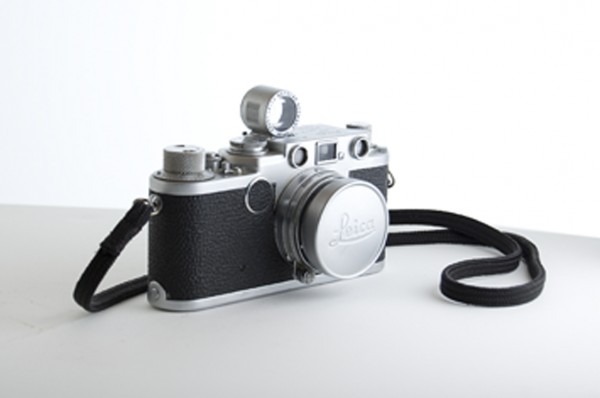
Produced in Germany by Leica Camera AG, the Leica Camera popularized the 35 mm format and is considered to be responsible for the beginning of modern photojournalism. The camera used standard cinema film, and it’s small size made it ideal for photographing fast paced, and often dangerous, news events.
HENRI CARTIER-BRESSON AND THE LEICA
French photographer Henri Cartier-Bresson (1908-2004), often referred to as the father of photojournalism, began using the 35mm format in 1931, when he purchased a Leica camera, much like the one displayed here. Cartier-Bresson photographed often for Life Magazine, travelling to places like Russia and China,
Cartier-Bresson described his style as the Decisive Moment:
“it is the simultaneous recognition, in a fraction of a second, of the significance of an event as well as the precise organization of forms which gives that event its proper expression.”
35mm CAMERAS
This became the most popular film and camera format, both among professionals and amateurs. Sturdy and multifunctional, with interchangeable lenses, these cameras found their way into civil wars, riots, and natural disasters around the necks of daring photojournalists. Once exposed, the film was wound conveniently back into light-tight metal canisters that would protect the film until it could be developed.
CHARLES MOORE
American Civil Rights photographer Charles Moore is most known for his photographs of the Children’s Crusade in Birmingham Alabama in 1964. His powerful images of the struggle for civil rights were published in the book “Powerful Days”. Photographs like these helped raise awareness of the need for a Civil Rights act in America.
For more information or to see more from the Toronto Metropolitan University Library Special Collections, email asc@ryerson.ca or call 416-979-5000 ext. 4996.
For more information on the Ryerson Image Centre or the Black Star Collection, please visit their website at http://www.ryerson.ca/ric/ or cal 416-979-5164.
